Sequences and Infinite Series
Sequences
Introduction to sequences
A sequence is an ordered list of numbers e.g. a finite sequence $\{1, 4, 7, 10\}$ and e.g. an infinite sequence $\{3, 7, 11, 15, ...\}$.
We can denote finite sequences this way:
$$ \begin{align} (a_k)_{k=1}^4 = (1, 4, 7, 10) \end{align} $$This is verbally expressed as “a sub k for k is going from 1 to 4.”
Given this sequence we can say that:
$$ \begin{align} a_1 = 1 \end{align} $$“a sub 1 equals 1”
$$ \begin{align} a_2 = 4 \end{align} $$“a sub 2 equals 4”
and so on
We could express the same sequence with a function instead:
$$ \begin{align} (a_k)_{k=1}^4 \text{ with } a_k = 1 + 3(k -1) \end{align} $$more traditional function notation would express the function as
$$ \begin{align} a(k) = 1 + 3(k - 1) \end{align} $$We can denote an infinite sequence this way:
$$ \begin{align} (a_k)_{k=1}^\infty = {3, 7, 11, 15, \dots} \end{align} $$and as a function
$$ \begin{align} (a_k)_{k=1}^\infty \text{ with } a_k = 3 + 4(k - 1) \end{align} $$In addition to using explicit functions–see the functional notation used above–we can also define sequences using recursive functions.
Not all sequences can be defined as either an explicit function or a recursive function.
A recursive function is a sequence in which the value of each successive term depends on the term before it. This is the same function above expressed recursively:
$$ \begin{align} (a_k)_{k=1}^4 \text{ with } a_k = a_{k - 1} + 3 \text{ with } a_1 = 1 \end{align} $$This tells us to take the previous term and add it to 3:
$$ \begin{align} a_{k-1} + 3 \end{align} $$We are told that the first term is 1:
$$ \begin{align} a_1 = 1 \end{align} $$This is a base case, i.e. a case which is not defined in terms of the function.
So at $k = 2$–the second term, we take the first term ($1$) and add it to three to get four. At $k = 3$–the third term, we take the second term ($4$) and add it to three to get seven. And, so on.
Infinite sequence expressed as a recursive function:
$$ \begin{align} (a_k)_{k=1}^\infty \text{ with } a_k = a_{k - 1} + 4 \text{ with } a_1 = 3 \end{align} $$How to evaluate recursive formulas of sequences (example)
Given
$$ \begin{align} g(n) = \begin{cases} 4 & \text{if } n = 1 \\ g(n - 1) + 3.2 & \text{if } n > 1 \text{ and whole number} \end{cases} \end{align} $$We can determine the results for $g(1)$, $g(2)$, $g(3)$, $g(4)$:
First we can determine using the base case:
$$ \begin{align} g(1) = 4 \end{align} $$In order to solve for $g(2)$, we use the second case ($n > 1$). We must first find $g(n - 1)$ i.e $g(1)$–which equals $4$. We can now express $g(2)$ as:
$$ \begin{align} g(2) = 4 + 3.2 = 7.2 \end{align} $$$g(3)$ solved:
$$ \begin{align} g(3) = 7.2 + 3.2 = 10.4 \end{align} $$$g(4)$ solved:
$$ \begin{align} g(4) = 10.4 + 3.2 = 13.6 \end{align} $$We can express these values as a sequence:
$$ \begin{align} (4, 7.2, 10.4, 13.6, \dots) \end{align} $$Arithmetic sequences
An arithmetic sequence is a sequence where each term is a fixed number smaller/larger than the previous term.
$(-5, -3, -1, 1, ...)$ is an arithmetic sequence
an explicit definition of the function for this sequence is:
$$ \begin{align} (a_n)_{n=1}^\infty \text{ with } a_n = -5 + 2(n - 1) \end{align} $$Our first term is $-5$, and we add $2$ multiplied by the term we are on.
a recursive definition of the function for this sequence is:
$$ \begin{align} a_1 = -5 \\ a_n = a_{n-1} + 2 \text{ for } n \ge 2 \end{align} $$Here is an explicit definition of an arithmetic sequence in general form:
$$ \begin{align} (a_n)_{n=1}^\infty \text{ with } a_n = K + \Delta(n - 1) \end{align} $$“a sub n” is equal to some constant plus some number incremented/decremented ($\Delta$).
Here is a recursive definition of an arithmetic sequence in general form:
$$ \begin{align} a_1 = K \\ a_n = a_{n-1} + \Delta \text{ for } n \ge 2 \end{align} $$“a sub n is equal to a sub n minus 1 + d for n greater than or equal to two”
$(1, 3, 6, 10, ...)$ is not an arithmetic sequence–$3 - 1 = 2 \ne 6 - 3$
However, we could define the sequence with a recursive function
$$ \begin{align} (a_n)_{n=1}^\infty \text{ with } a_1 = 1 \\ a_n = a_{n - 1} + n \text{ for } n \ge 2 \end{align} $$Here we add the index to the previous term.
How to find the 100th term of a sequence given the first four terms (example)
Given the sequence:
$$ \begin{align} (15, 9, 3, -3, ...) \end{align} $$What is the 100th term in this sequence?
One approach is to place the values in a table:
+—–+—–+ |Term |Value| +—–+—–+ | 1 | 15 | +—–+—–+ | 2 | 9 | +—–+—–+ | 3 | 3 | +—–+—–+ | 4 | -3 | +—–+—–+
We can discern that going from the first term to the second term we subtract six once. Going from the first term to the third term we subtract six twice. So depending on what term you are on you multiply one less the current term by negative three.
$$ \begin{align} 15 - (0) \cdot 6 \\ 15 - (1) \cdot 6 \\ 15 - (2) \cdot 6 \\ 15 - (3) \cdot 6 \\ 15 - (n - 1) \cdot 6 \end{align} $$We can solve for the 100th term by plugging in the 100 to the formula:
$$ \begin{align} 15 - (100 - 1) \cdot 6 = -579 \end{align} $$We could also express this with an explicit function definition:
$$ \begin{align} (a_n)_{n=1}^\infty \text{ with } a_n = 15 - 6(n - 1) \end{align} $$Now, we can plug in 100 and solve
$$ \begin{align} a_n = 15 - 6(100 - 1) = -579 \end{align} $$Constructing arithmetic sequences
Given the table:
+—–+—–+ |f(n) | n | +—–+—–+ | 12 | 1 | +—–+—–+ | 5 | 2 | +—–+—–+ | -2 | 3 | +—–+—–+ | -9 | 4 | +—–+—–+
We can also express this as a sequence:
$$ \begin{align} (12, 5, -2, -9) \end{align} $$And write an explicit formula for $n$:
$$ \begin{align} f(n) = 12 - 7(n - 1) \end{align} $$where 12 is our first term, and for each term we add 12 to -7 multiplied by one less than the number of the current term.
How to convert between the recursive formula and the explicit formula of an arithmetic sequence (example)
Given the function:
$$ \begin{align} h(n) = -31 -7(n - 1) \end{align} $$We can make a table:
+—–+———————+ | n |h(n) | +—–+———————+ | 1 |-31 - 7(1 - 1) = -31 | +—–+———————+ | 2 |-31 - 7(2 - 1) = -38 | +—–+———————+ | 3 |-31 - 7(3 - 1) = -45 | +—–+———————+ | 4 |-31 - 7(4 - 1) = -52 | +—–+———————+
And from this table we can create a sequence:
$$ \begin{gather} (-31, -38, -45, -52, \dots) \end{gather} $$We start at $-31$ and with each successive term we subtract $-7$ multiplied by one less than the current term number. And, from this sequence we can create a recursive formula:
$$ \begin{gather} g(n) = \begin{cases} -31 & \text{if } n = 1 \\ g(n - 1) -7 & \text{if } n \gt 1 \text{and a whole number} \end{cases} \end{gather} $$Given the recursive formula:
Our first term 9.6 and with each term we subtract 1 from the previous term
$$ \begin{gather} h(n) = \begin{cases} 9.6 & \text{if } n = 1\\ h(n - 1) - 0.1 & \text{if } n > 1 \text{ and a whole number} \end{cases} \end{gather} $$We can express a sequence in this way:
$$ \begin{gather} (9.6, 9.5, 9.4, 9.3, \dots) \end{gather} $$And as a table:
+—–+—————-+ | n |h(n) | +—–+—————-+ | 1 |9.6 | +—–+—————-+ | 2 |h(1) - 0.1 = 9.5| +—–+—————-+ | 3 |h(2) - 0.1 = 9.4| +—–+—————-+ | 4 |h(3) - 0.1 = 9.3| +—–+—————-+
And from this we can create an explicit function:
$$ \begin{align} f(n) = 9.6 - 0.1(n - 1) \end{align} $$Introduction to geometric sequences
A geometric sequence is a special sequence where each successive number is a fixed multiple of the number before it e.g. $(2, 6, 18, 54, \dots)$. $2$ is term 1 i.e. a₁ and the number that each term is multiplied by is called the common ratio i.e. $r$, in this case $3$.
A series is a sum of a sequence. A geometric series is the sum of a geometric sequence. The series for the sequence (2, 6, 18, 54) is 2 + 6 + 18 + 54.
Consider a bungee cord that stretches with each successive bounce. Prior to the first bounce the cord stretches 120 ft, and on each successive bounce the stretch is 60% of the previous stretch.
From this we can derive
$a_0 = 120\text{ft and } r = 0.6$
We can document these values in a table:
+————+——————–+ | Bounce (n) |Stretches f(n) | +————+——————–+ | 0 |$0.6^0(120) = 120$ | +————+——————–+ | 1 |0.6(120) = 72 | +————+——————–+ | 2 |0.6 x 0.6(120) | +————+——————–+ | 3 |0.6 x 0.6 x 0.6(120)| +————+——————–+
From this table we can create a formula to determine the stretch on the n-th jump
$$ \begin{gather} f(n) = 120(0.6)^{n} \end{gather} $$To determine the stretch on the twelfth bounce we can setup the formula like this:
$$ \begin{gather} f(n) = 120(0.6)^{12} = 0.26 \text{ft } \end{gather} $$Sequences and Infinite Series
Overview
Sequences
A sequence is an ordered list of numbers, $a_1, a_2, \dots,$.
Each number in the sequence is called a term of the sequence. We denote sequences in any of the following forms:
$$ \begin{gather} \{a_1, a_2, a_3, \dots, a_n, \dots \}\\ \{a_n\}_{n = 1}^{\infty}\\ \{a_n\} \end{gather} $$The subscript $n$ that appears in $a_n$ is called an index, and it indicates the order of terms in the sequence. The starting index is arbitrary, but usually $n = 0$ or $n = 1$. The $\dots$ mean that the sequence continues indefinitely.
It is of interest whether a sequence approaches some value for very large values of $n$. A sequence is said to converge if it approaches some value as $n \to \infty$. A sequence is said to diverge if it is unbounded or does not approach any value. The intuition is really what happens to the next term. Is it smaller, bigger, etc.?
Sequence that Converges
The following sequence approaches $n^2/n^2 = 1$:
$$ \begin{gather} a_n = \frac{(n + 8)(n + 1)}{n(n - 10)}\\ = \frac{n^2 + 9n + 8}{n^2 - 10n} \end{gather} $$Sequences that Diverge
This sequence diverges because the numerator grows much faster than the denominator and so grows unbounded.
$$ b_n = \frac{e^n + 1}{e \cdot n + 1} $$This sequence is said to diverge because it never approaches any value:
$$ c_n = (-1)^n $$Instead, it oscillates between $-1$ and $1$,
Types of Sequences
- $\{a_n\}$ is increasing if $a_{n + 1} > a_n$; for example, $\{0, 1, 2, 3, \dots\}$
- $\{a_n\}$ is nondecreasing if $a_{n + 1} \geq a_n$; for example, $\{1, 1, 2, 2, 3, 3, \dots\}$
- $\{a_n\}$ is decreasing if $a_{n + 1} < a_n$; for example, $\{2, 1, 0, -1, \dots\}$
- $\{a_n\}$ is nonincreasing if $a_{n + 1} \leq a_n$; for example, $\{0, -1, -1, -2, -2, -3, -3, \dots\}$
- $\{a_n\}$ is monotonic if it is either nonincreasing or nondecreasing (it moves in one direction).
- $\{a_n\}$ is bounded if there is a number $M$ such that $|a_n| \leq M$, for all relevant values of $n$.
Recurrence Relations
A recurrence relation (or implicit formula) is a way of defining a sequence by providing an initial term, and a general rule from computing the next term from the previous term.
If you have $\{1, 4, 7, 10, \dots \}$, the recurrence relation is:
$$ a_{n + 1} = a_n + 3, a_1 = 1, \text{ for } n = 1, 2, 3, \dots $$Explicit Formula
An explicit formula we can determine the $n$th term of a sequence directly. An explicit formula is more desirable than a recurrence relation. Here we convert a recurrence relation for ${1, 4, 7, 10, \dots}$ to an explicit formula by first observing a pattern:
$$ \begin{gather} a_1 = 1\\ a_2 = 1 + (3 \cdot 1)\\ a_3 = 1 + (3 \cdot 2)\\ a_4 = 1 + (3 \cdot 3)\\ \end{gather} $$Observe that the $n$th term of the sequence is $1$ plus $3$ multiplied by $n - 1$, or
$$ \begin{gather} a_n = 1 + 3(n - 1)\\ = 3n - 2, \text{ for } n = 1, 2, 3, \dots \end{gather} $$Now we can determine $n$th without calculating the previous terms. So, for $n = 147$ we have:
$$ a_{147} = 3 \cdot 147 - 2 = 439 $$Limit of a Sequence
If the terms of a sequence $\{a_n\}$ approach a unique number $L$ as $n$ increases—that is, if $a_n$ can be made arbitrarily close to $L$ by taking $n$ sufficiently large—then we say $\lim_{n \to \infty} a_n = L$ exists, and the sequence converges to $L$. If the terms of the sequence do not approach a single number as $n$ increases, the sequence has no limit, and the sequence diverges.
Given the sequence:
$$ \left\{ \frac{(-1)^n}{n^2 + 1}\right\}^{\infty}_{n = 1} $$The first four terms are:
$$ \left\{-\frac{1}{2}, \frac{1}{5}, -\frac{1}{10}, \frac{1}{17}, \dots \right\} $$The limit appears to be $0$
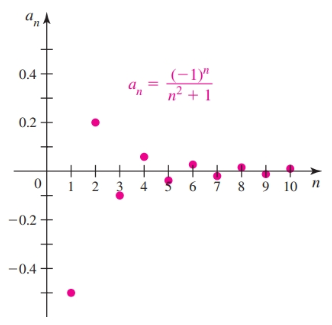
Given the sequence:
$$ \{\cos n \pi \}_{n = 1}^{\infty} $$The first four terms are:
$$ \{-1, 1, -1, 1, \dots \} $$The terms of sequence alternate and never approach a single value so this sequence is said to diverge:
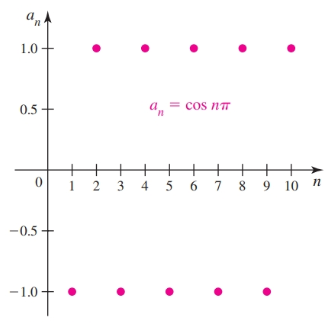
Given the sequence:
$$ \{a_n\}_{n = 1}^{\infty}, a_{n + 1} = -2a_n, a_1 = 1 $$The first four terms are:
$$ \{1 -2, 4, -8, \dots\} $$Because the magnitudes of the terms increase without bound, the sequence diverges:
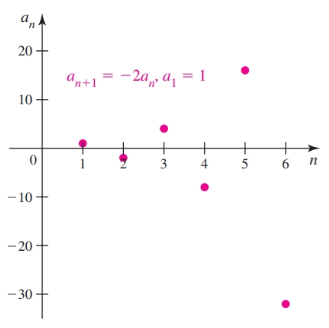
Infinite Series and the Sequence of Partial Sums
An infinite series is a sum of an infinite set of numbers.
Given a sequence $\{a_1, a_2, a_3, \dots \}$, the sum of its terms can be expressed as
$$ a_1 + a_2 + a_3 + \dots = S = \sum_{k = 1}^{\infty} a_k $$A partial sum of the previous expression is the summing of some subset of the terms starting with $a_1$ e.g.:
$$ S_3 = a_1 + a_2 + a_3 = \sum_{k = 1}^{3} a_k $$The sequence of partial sums $\{S_n\}$ associated with this series has the terms:
$$ S_n = a_1 + a_2 + a_3 + \dots + a_n = \sum_{k = 1}^n a_k, \text{ for } n = 1, 2, 3, \dots $$It may be the case that we have some formula for $S_n$ allowing us to find the partial sum for any $n$:
$$ S_n = \frac{n + 1}{n + 10} $$With this information we can determine any $a_n$. Recall that the sequence of partial sums is:
$$ a_1 + a_2 + a_3 + \dots + a_{n - 1} + a_{n} $$Observe that it is possible to find the last term $a_n$ with the following equation
$$ a_n = S_n - S_{n - 1} $$Therefore:
$$ \begin{gather} a_n = \frac{n + 1}{n + 10} - \frac{(n - 1) + 1}{(n - 1) + 10}\\ = \frac{(n + 1)(n + 9)}{(n + 10)(n + 9)} - \frac{n(n + 10)}{(n + 9)(n + 10)}\\ a_n = \frac{9}{(n + 9)(n + 10)} \end{gather} $$Given the infinite series $S = \sum_{k = 1}^{\infty} a_k = a_1 + a_2 + \dots$ and formula for the $k$th partial sum
$$ S_k = \frac{2k^3}{(k + 1)(k + 2)} $$Observe that $S$ is the limit of $S_k$ as $k \to \infty$:
$$ S = \lim_{k \to \infty} S_k = \lim_{k \to \infty} \frac{2k^3}{(k + 1)(k + 2)} $$From here we can determine if the sequence of partial sums i.e. the series diverges or converges.
Given the infinite series:
$$ \sum_{k = 1}^{\infty} \frac{1}{k(k + 1)} $$we have the following sequences of partial sums:
$$ \begin{gather} S_1 = \frac{1}{2} = \frac{1}{2}\\ S_2 = \frac{1}{2} + \frac{1}{6} = \frac{2}{3}\\ S_3 = \frac{1}{2} + \frac{1}{6} + \frac{1}{12} = \frac{3}{4}\\ S_4 = \frac{1}{2} + \frac{1}{6} + \frac{1}{12} + \frac{1}{20} = \frac{4}{5}\\ \end{gather} $$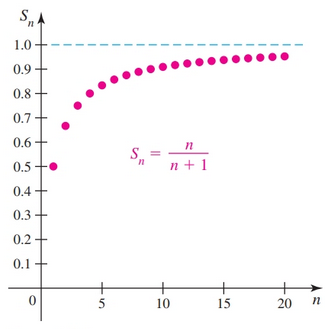
Based on the pattern in the sequence of partial sums, a reasonable conjecture is that $S_n = \frac{n}{n + 1}$, for $n = 1, 2, 3, \dots$, which produces the sequence $\{\frac{1}{2}, \frac{2}{3}, \frac{3}{4}, \frac{4}{5}, \frac{5}{6}, \dots \}$. Because $\lim_{n \to \infty} \frac{n}{n + 1} = 1$, we claim that
$$ \sum_{k = 1}^{\infty} \frac{1}{k(k + 1)} = \lim_{n \to \infty} S_n = 1 $$Geometric Sequences and Series
Geometric sequences have the property that each term is obtained by multiplying the previous term by a fixed constant, called the ratio. They have the form $\{r^n\}$ or $\{ar^n\}$, where the ratio $r$ and $a$ are real numbers.
$$ \begin{gather} 8 + \frac{8}{3} + \frac{8}{9} + \dots\\ 8 + 8\left(\frac{1}{3}\right) + 8\left(\frac{1}{3}\right)^2 + \dots \end{gather} $$When $|r| < 1$ the resulting numbers decrease to $0$.
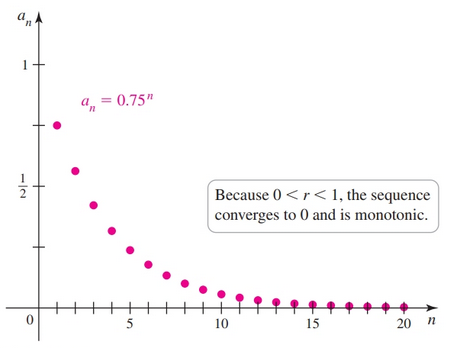
When $-1 < r < 0$, e.g. ${(-0.75)^n}$ the resulting sequence oscillates and converges to $0$.
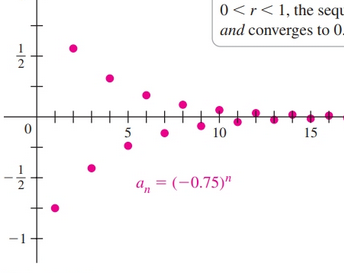
When $r > 1$ then resulting numbers increase in magnitude without bound (diverges).
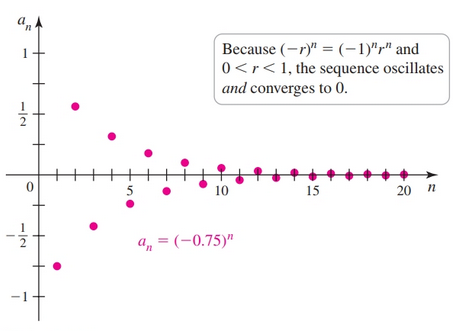
When $r < -1$ the resulting sequence oscillates and does not converge (diverges).
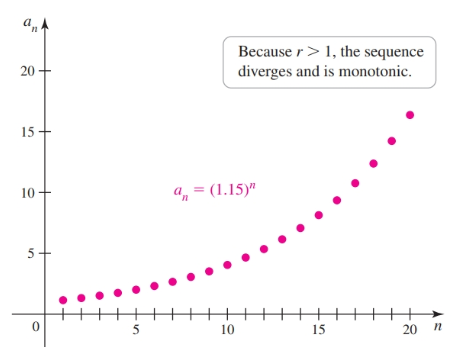
Geometric Series
Here is the geometric sequence from the beginning expressed as an infinite series:
$$ \sum_{k = 0}^{\infty} 8 \left(\frac{1}{3}\right)^k $$There are multiple ways to express geometric series.
$$ \sum_{k = 0}^{\infty} ar^k = \sum_{k = 1} ar^{k - 1} = \sum_{k = 5} ar^{k - 5} $$When $|r| < 1$ we can find the sum of the series with:
$$ \frac{a}{1 - r} $$Strategies
Given a series such as:
$$ \sum_{j = 1}^{\infty} 8^{-2j} $$We can refactor:
$$ \begin{gather} 8^{-2j}\\ (8^{-2})^j\\ (8^{-2})(8^{-2})^{j - 1} \end{gather} $$Given a series such as:
$$ \sum_{k = 1}^{\infty} \frac{3^k}{8^k}\\ $$We can refactor:
$$ \begin{gather} \frac{3^k}{8^k}\\ \left(\frac{3^k}{8^k}\right)\\ \left(\frac{3}{8}\right)^k\\ \left(\frac{3}{8}\right)\left(\frac{3}{8}\right)^{k - 1}\\ \end{gather} $$If $k \ne 1, k > 1$, simply find the series, then subtract the missing terms:
$$ \sum_{k = 3}^{\infty} \frac{3}{8}^{k - 1} = \sum_{k = 1}^{\infty} \frac{3}{8}^{k - 1} - \frac{3}{8}^{(3) - 1} - \frac{3}{8}^{(2) - 1} $$When $k = 0$, our form the series must be:
$$ \sum_{k = 0}^{\infty} -\frac{5}{6}^{k}\\ $$In this case, $r = -\frac{5}{6}$ and $a = 1$
A rational and repeating number such as $0.161616 \dots$ can be expressed as the sequence:
$$ 0.16 + 0.0016 + 0.000016 + \dots $$Each term is some ratio ($r$) times the previous number ($.01$). Therefore, this number can be expressed as a geometric series:
$$ \sum_{k = 1}^{\infty} 16 \left(\frac{1}{100}\right)^{k - 1} $$Telescoping Series
Given a series such as:
$$ \sum_{k = 1}^{\infty} \left( \frac{1}{k} - \frac{1}{k + 1} \right) $$We can find an explicit formula for the $n$th term of the sequence of partial sums ${S_n}$ by expressing the series in a way that allows it to be collapsed (we cancel out terms):
$$ S_n = \left[ \left( \frac{1}{1} - \frac{1}{2} \right) + \left(\frac{1}{2} - \frac{1}{3}\right) + \dots + \left(\frac{1}{n - 1} - \frac{1}{(n - 1) + 1}\right) + \left(\frac{1}{n} - \frac{1}{n + 1} \right) \right]\\ $$Observe that the series end at the expression from the original series i.e.:
$$ \left(\frac{1}{n} - \frac{1}{n + 1} \right) $$And, that we have backtracked from this to an expression that has the first operand as the second operand:
$$ \begin{gather} \left(\frac{1}{n - 1} - \frac{1}{(n - 1) + 1)} \right)\\ = \left(\frac{1}{n - 1} - \frac{1}{n} \right)\\ \end{gather} $$After cancelling terms we have the expression:
$$ S_n = \left[ \frac{1}{1} - \frac{1}{n + 1} \right]\\ $$Now, we can find sum for any series given $n$.
Next, we can find find the limit of $S_n$ as $n \to \infty$:
$$ \begin{gather} \lim_{n \to \infty} S_n = \left[ \frac{1}{1} - \frac{1}{\infty + 1} \right]\\ = [ 1 - 0 ]\\ = 1 \end{gather} $$This tells us that series will eventually converge at $1$.
Strategies
Factor out any large terms:
$$ \begin{gather} \sum_{k = 1}^{\infty} \left( \frac{12}{k} - \frac{12}{k + 1} \right) 12 \sum_{k = 1}^{\infty} \left( \frac{1}{k} - \frac{1}{k + 1} \right) \end{gather} $$Given a series such as:
$$ \sum_{k = 1}^{\infty} \frac{1}{(k + 5)(k + 6)} $$Use the method of partial fractions:
$$ \sum_{k = 1}^{\infty} \frac{1}{k + 5} - \frac{1}{k + 6} $$P-Series and Harmonic Series
A p-series has the general form:
$$ \sum_{k = 1}^{\infty} = \frac{1}{k^p}, p \in \mathbb{R} $$A p-series converges for $P > 1$, otherwise diverges.
The harmonic series is a P-series:
$$ \sum_{k = 1}^{\infty} = \frac{1}{k}, p \in \mathbb{R} $$Alternating Series
Alternating series have terms which alternate in sign e.g.:
$$ \sum_{k = 1}^{\infty} \frac{(-1)^{k + 1}}{k} = 1 - \frac{1}{2} + \frac{1}{3} - \frac{1}{4} + \frac{1}{5} - \frac{1}{6} + \dots $$The factor $(-1)^{k + 1}$ has the pattern $\{\dots, 1, -1, 1, -1, \dots \}$, providing the alternating signs.
The alternating harmonic series has the form:
$$ \sum_{k = 1}^{\infty} \frac{(-1)^{k + 1}}{k} $$Recall that with a regular harmonic series $k > 1$ converges.
It turns out that the alternating harmonic series does converge.
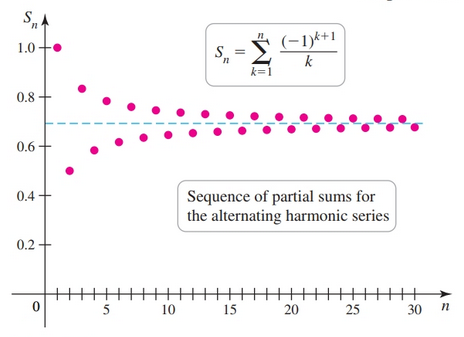
Divergence Test
If the limit as our $k$th term approaches $\infty$ does not equal $0$, then the series diverges. Said another way: if the series does not diverge, then the limit as the $k$th term approaches $\infty$ equals $0$.
Given:
$$ \sum_{k = 1}^{\infty} a_k $$If
$$ \lim_{k \to \infty} a_k \ne 0 $$Then the series diverges.
Intuitively, if the limit is not $0$ then we know that the series continues to add numbers and so sum never converges. Observe the conditional nature of the test i.e. if
$$ \lim_{k \to \infty} a_k = 0 $$Then the test is inconclusive, and other tests are required to determine if the series converges or diverges.
The Integral Test
In order to use the integral test, we make a connection between the infinite series and the integral.
In order use the integral test, the following must be true for $f(k)$:
- is continuous on $[1, \infty)$
- is positive for $x \geq 1$
- decreasing
Given the following series:
$$ \sum_{k = 1}^{\infty} a_k $$We find the limit of the improper integral for $f(x) = a_k$ to determine whether or not the series convertges. The lower limit is the first value for $k$ and the upper bound is $\infty$:
$$ L = \lim_{b \to \infty} \int_{1}^{b} f(x) dx $$If $L = \infty$ then the series is divergent; otherwise, the sum converges at $L$.
Ratio Test
Given a series take limit of $a_{k + 1}$ divided by $a_k$ as $k \to \infty$ to find the ratio between the two terms.
$$ r = \lim_{k \to \infty} \frac{a_{k + 1}}{a_k} $$- If $0 \leq r \lt 1$, the series converges.
- If $r > 1$, the series diverges.
- If $r = 1$, the test is inconclusive.
Strategies
Series containing factorials are particularly amenable to the ratio test:
Comparison Test
Given two series:
$$ \begin{gather} \sum_{n = 1}^{\infty} a_n\\ \sum_{n = 1}^{\infty} b_n \end{gather} $$and the following conditions for $n = 1, 2, 3, \dots$:
$$ \begin{gather} a_n, b_n \geq 0\\ a_n \leq b_n \end{gather} $$We can reason that $a_n$ is bounded by $b_n$. Therefore, if $\sum_{n = 1}^{\infty} b_n$ converges, then $\sum_{n = 1}^{\infty} a_n$ also converges.
Contrarily, we can also reason that if $\sum_{n = 1}^{\infty} a_n$ diverges, then $\sum_{n = 1}^{\infty} b_n$ also diverges.
Limit Comparison Test
Given some infinite series $\sum a_k$ we use second related series $\sum b_k$ to determine if $\sum a_k$ converges.
Series $b_k$ is one such that through multiplication, the numerator and denominator in series $a_k$ have the same degree.
More specifically, we are finding the limit of $a_k$ divided by $b_k$
$$ \lim_{k \to \infty} \frac{a_k}{b_k} = L $$If $0 < L < \infty$, then $\sum a_k$ and $\sum b_k$ either both converge or both diverge.
If $L = 0$ and $\sum b_k$ converges, then $\sum a_k$ converges.
If $L = \infty$ and $\sum b_k$ diverges, then $\sum a_k$ diverges.
Strategies
This test is helpful with series that are expressed in terms of rational functions:
$$ \sum_{k = 1}^{\infty} \frac{1}{4k^{\frac{8}{7}} + 4} $$In this case, we choose $\sum b_k$ of:
$$ \sum_{k = 1}^{\infty} \frac{1}{k^{\frac{8}{7}}} $$Which happens to converge.
Finding the limit of $\frac{a_k}{b_k}$, we have:
$$ \begin{gather} \lim_{k \to \infty} \frac{\frac{1}{4k^{\frac{8}{7}} + 4}} {\frac{1}{k^{\frac{8}{7}}}}\\ = \frac{k^{\frac{8}{7}}}{4k^{\frac{8}{7}} + 4} = \frac{1}{4} \end{gather} $$Since $\sum b_k$ converges and $0 < L < \infty$, $\sum a_k$ converges.
When $a_k$ is a root term take care to choose a $b_k$ that is not under a radical:
$$ \sum_{k = 1}^{\infty} \sqrt{\frac{4k^3}{4k^5 + 7}} $$Here, we choose $b_k = \frac{1}{k}$.
Some expressions are even tricker:
$$ \sum_{k = 1}^{\infty} \frac{4}{k \sqrt{k + 7}} $$We can modify $a_k$:
$$ \frac{4}{\sqrt{k^3 + 7k^2}} $$We choose a $b_k$ of:
$$ \frac{1}{\sqrt{k^3}} $$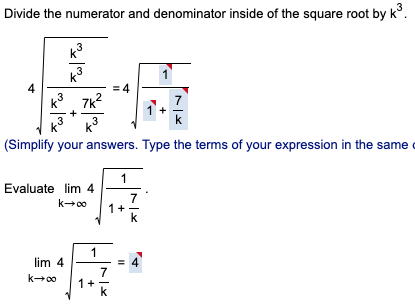
Alternating Series Test
Given the alternating series $\sum_{k = 1}^{\infty} a_k, where $a_k = (-1)^k b_k$ or $a_k = (-1)^{k + 1} b_k$ where $b_k \geq 0$ it will converge if:
- $\lim_{k \to \infty} b_k = 0$
AND
- The sequence ${b_k}$ is decreasing e.g $1 - \frac{1}{2} + \frac{1}{3} - \frac{1}{4} + \dots$
The nature of this test is conditional. We can use it to prove that a series converges, but we cannot use it to prove that a series diverges.
Strategies
Given a sequence we factor out the term that makes the series alternating:
$$ \begin{gather} \sum_{n = 1} \frac{(-1)^{n + 1}}{n}\\ a_n = \frac{(-1)^{n + 1}}{n} = (-1)^{n + 1} \cdot \frac{1}{n}\\ b_n = \frac{1}{n} \end{gather} $$Now, we can perform the test.
You may not be able to take the absolute value; instead, you will remove the part of the expression that causes series to alternate:
$$ \sum_{k = 1}^{\infty} \frac{\cos \pi k}{k^2} $$Here, we evaluate the following instead:
$$ \sum_{k = 1}^{\infty} \frac{1}{k^2} $$Conditional and Absolute Convergence
Given the following series
$$ \sum_{n = 1} \frac{(-1)^{n + 1}}{n} $$which converges per the alternating series test, we can further classify it based on what happens when we take the absolute value of each term in the sequence:
$$ \sum_{n = 1} \left| \frac{(-1)^{n + 1}}{n} \right| $$When we take the absolute value of this series we end up with the harmonic series:
$$ \sum_{n = 1} \left| \frac{1}{n} \right| $$Since this series diverges, we say that the original series converges conditionally. This is an example of conditional convergence.
If on the other hand we end up with a series that converges. The series is an example of absolute convergence.
Alternating Series Remainder
Given the following alternate series:
$$ \sum_{n = 1}^{\infty} \frac{(-1)^{n + 1}}{n^2} $$We can create an estimate for $S$. First we split our series into a partial sum $S_n$ for some $n$ and $R_n$ for the remainder:
$$ S = \underbrace{1 - \frac{1}{4} + \frac{1}{9} - \frac{1}{16}}_{S^4} + \underbrace{\frac{1}{25} - \frac{1}{36} + \frac{1}{49} - \frac{1}{64} + \dots}_{R_4} $$$$ S = \frac{115}{144} + R_4 $$Examining $R_4$ we can establish that $R_4 > 0$:
$$ R_4 = \left(\frac{1}{25} - \frac{1}{36}\right) + \left(\frac{1}{49} - \frac{1}{64}\right) + \dots $$Secondly, we can establish that $R_4 < \frac{1}{25}$:
$$ R_4 = \frac{1}{25} - \left(\frac{1}{36} + \frac{1}{49}\right) - \left(\frac{1}{64} + \frac{1}{81} \right) - \dots $$Therefore, we can find an upper and lower bound for $S$:
$$ \begin{gather} \frac{115}{144} \lt S \lt \frac{115}{144} + \frac{1}{25}\\ 0.7986\bar{1} < S < 0.8386\bar{1} \end{gather} $$In our approximation the magnitude of our error is no greater than the first term of our remainder sequence i.e. $\frac{1}{25}$.
Power Series
A power series is an infinite series of the form
$$ \sum_{k = 0}^{\infty} c_k x^k = \underbrace{c_0 + c_1 x + c_2 x^2 + \dots + c_n x^n}_{n\text{degree polynomial}} + \underbrace{c_{n + 1} x^{n + 1} + \dots}_{\text{terms continue}} $$Or, more generally,
$$ \sum_{k = 0}^{\infty} c_k (x - a)^k = \underbrace{c_0 + c_1 (x - a) + c_2 (x - a)^2 + \dots + c_n (x - a)^n}_{n\text{degree polynomial}} + \underbrace{c_{n + 1} (x - a)^{n + 1} + \dots}_{\text{terms continue}} $$where the center of the series $a$ and the coefficients $c_k$ are constants. This type of series is called a power series because it consists of powers of $x$ or $(x - a)$.
Viewed another way, a power series is built up from polynomials of increasing degree:
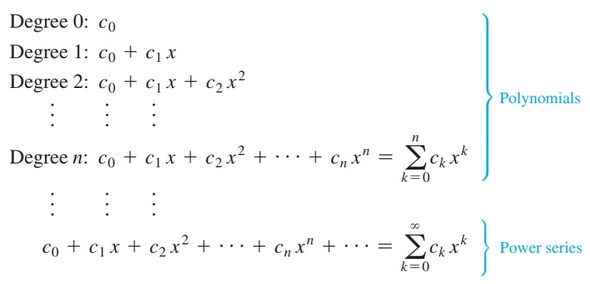
In general power series are use to represent familiar functions such as trigonometric, exponential, and logarithmic functions. They are also used to define new functions. For example, consider the function defined by
$$ g(x) = \sum_{k = 1}^{\infty} \frac{(-1)^k k}{4^k}x^{2k} $$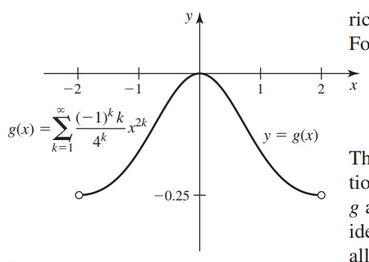
g appears to be an ordinary continuous and differentiable function on 1-2, 22 (which is identified at the end of the chapter). In fact, power series satisfy the defining property of all functions: For each admissible value of x, a power series has at most one value. For this reason, we refer to a power series as a function, although the domain, properties, and identity of the function may need to be discovered.
Convergence and Divergence
Given the power series
$$ \sum_{k = 0}^{\infty} c_k (x - a)^k $$The set of values of $x$ for which the series converges is its interval of convergence. The radius of convergence of the power series, denoted $R$, is the distance from the center of the series to the boundary of the interval of convergence.
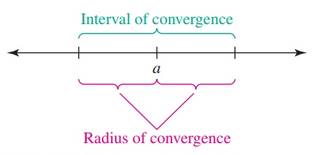
Taylor Polynomials
Given a function $f(x)$ we can approximate it with a polynomial under the following assumptions:
- we can evaluate $f(0)$
- we can evaluate $f'(0), f''(0), f'''(0), f^{(4)}, \dots, f^{(n)}$
Our first estimate $p(x)$ consists of 1 term and must meet the criteria that $p(0) = f(0)$:
$$ p(x) = f(0) $$This constant function allows for $f(x)$ and $p(x)$ to have the same value at $x = 0$:
- $x = 0, f(0) = p(0)$
Our second estimate $p(x)$ conists of 2 terms; we add to our criteria that $p'(0) = f'(0)$:
$$ p(x) = f(0) + f'(0)x $$The commonalities include:
- $x = 0$, $f(0) = p(0)$
- $p'(x) = f'(0)$ so $p'(0) = f'(0)$
Our third esimate is:
$$ p(x) = f(0) + f'(0)x + \frac{1}{2}f''(0)x^2 $$The commonalities now include:
- $x = 0, f(0) = p(0)$
- $p'(x) = f'(0) + f''(0)x$ so $p'(0) = f'(0)$
- $p''(x) = f''(0)$ so $p''(0) = f''(0)$
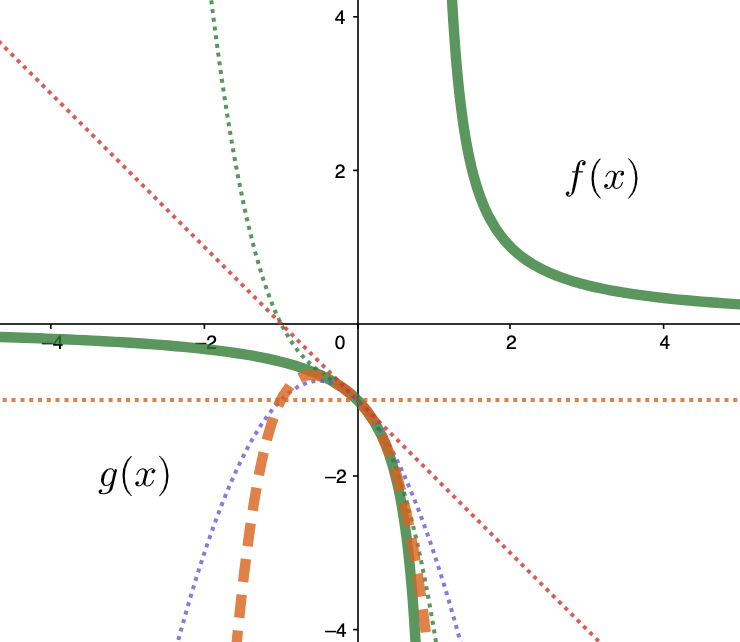
- Observe that each estimate gets better at describing $f(x)$
- $g(x)$ (the thick dashed line) is the most accurate for values near $0$
- the estimates are centered around $0$
We can describe this polynomial that follows this pattern more formally.
Let $f$ be a function with $f', f'', \dots, f^{(n)}$ defined at $a$. The $n$th-order Taylor Polynomial for $f$ with its center at $a$, denoted $p_n$, has the property that it matches $f$ in value, slope, and all derivatives up to the $n$th derivative at $a$; that is,
$$ \begin{gather} p_n(a) = f(a)\\ p_n'(a) = f'(a)\\ \dots\\ p_n^{(n)}(a) = f^{(n)}(a) \end{gather} $$The $n$th-order Taylor polynomial centered at $a$ is
$$ p_n(x) = f(a) + f'(a)(x - a) + \frac{f''(a)}{2!}(x - a)^2 + \dots + \frac{f^{(n)}(a)}{n!} (x - a)^n $$$p_n(x)$ can also written as $p_{n,a} (x)$ to include $a$ on the LHS.
More compactly,
$$ p_n(x) = \sum_{k = 0}^{n} c_k (x - a)^k $$, where the coefficients are
$$ c_k = \frac{f^{(k)}(a)}{k!}, \text{ for } k = 0, 1, 2, \dots, n $$If we write the $n$th-order Taylor polynomial for $f$ centered at $a$ and allow $n$ to increase indefinitely, a power series is obtained:
$$ c_0 + c_1(x - a) + c_2(x - a)^2 + \dots + c_n(x - a)^n + \dots = \sum_{k = 0} c_k (x - a)^k $$This is known as the Taylor series. When a Taylor series is centered at $0$ the series is known as a Maclaurin series.
Taylor Polynomial Remainder
Given a Taylor polynomial $p_n(x)$ that approximates a function $f(x)$ we can describe the amount of error with a remainder/error function $R_{n,a}(x)$ sometimes written as $E_{n,a}(x)$. $p(n)$
$$ R_{n,a}(x) = f(x) - p(x) $$The error increases the farther we go from $a$. More specifically the error is $0$ up to and including $p_{n,a}^(n)(a)$.
If we have
$$ p_n(x) = f(a) + f'(a)(x - a) + \frac{f''(a)}{2!}(x - a)^2 + \dots + \frac{f^{(n)}(a)}{n!} (x - a)^n $$Since
$$ \begin{gather} p(a) = f(a)\\ p'(a) = f'(a)\\ \vdots p^{(n)}(a) = f^{(n)}(a) \end{gather} $$Then
$$ \begin{gather} R_{n, a}(a) = f(a) - p(a) = 0\\ R_{n, a}'(a) = f'(a) - p'(a) = 0\\ \vdots R_{n, a}^{(n)}(a) = f^{(n)}(a) \end{gather} $$When we take the $n + 1$th derivative of $p(x)$ we get $0$, so:
$$ \begin{gather} R_{n, a}^{(n + 1)} = f^{(n + 1)}(x) - p^{(n + 1)}(x)\\ = R_{n, a}^{(n + 1)} = f^{(n + 1)}(x) - 0\\ = f^{(n + 1)}(x) \end{gather} $$Therefore,
$$ |R_{n, a}^{(n + 1)}(x)| = |f^{(n + 1)}(x)| \leq M $$Sources
- Calculus: Early Transcendentals by Briggs, Cochran, Gillett